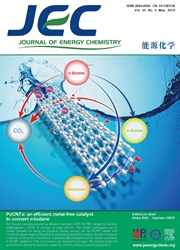

 中文摘要:
中文摘要:
Well-shaped and uniformly dispersed LiFePO4 nanorods with a length of 400–500 nm and a diameter of about 100 nm, are obtained with participation of a proper amount of anion surfactant sodium dodecyl sulfonate(SDS) without any further heating as a post-treatment. The surfactant acts as a self-assembling supermolecular template, which stimulated the crystallization of LiFePO4 and directed the nanoparticles growing into nanorods between bilayers of surfactant(BOS). LiFePO4 nanorods with the reducing crystal size along the b axis shorten the diffusion distance of Li+ extraction/insertion, and thus improve the electrochemical properties of LiFePO4 nanorods. Such prepared LiFePO4 nanorods exhibited excellent specific capacity and high rate capability with discharge capacity of 151 mAh/g, 122 mAh/g and 95 mAh/g at 0.1C, 1 C and 5 C, respectively. Such excellent performance of LiFePO4 nanorods is supposed to be ascribed to the fast Li+ diffusion velocity from reduced crystal size along the b axis and the well electrochemical conductivity. The structure, morphology and electrochemical performance of the samples were characterized by XRD, FE-SEM, HRTEM, charge/discharge tests, and EIS(electrochemical impedance spectra).
 英文摘要:
英文摘要:
Well-shaped and uniformly dispersed LiFePO 4 nanorods with a length of 400-500 nm and a diameter of about 100 nm, are obtained with participation of a proper amount of anion surfactant sodium dodecyl sulfonate (SDS) without any further heating as a post-treatment. The surfactant acts as a self-assembling supermolecular template, which stimulated the crystallization of LiFePO4 and directed the nanoparticles growing into nanorods between bilayers of surfactant (BOS). LiFePO4 nanorods with the reducing crystal size along the b axis shorten the diffusion distance of Li+ extraction/insertion, and thus improve the electrochemical properties of LiFePO4 nanorods. Such prepared LiFePO 4 nanorods exhibited excellent specific capacity and high rate capability with discharge capacity of 151 mAh/g, 122 mAh/g and 95 mAh/g at 0.1 C, 1 C and 5 C, respectively. Such excellent performance of LiFePO4 nanorods is supposed to be ascribed to the fast Li+ diffusion velocity from reduced crystal size along the b axis and the well electrochemical conductivity. The structure, morphology and electrochemical performance of the samples were characterized by XRD, FE-SEM, HRTEM, charge/discharge tests, and EIS (electrochemical impedance spectra). (C) 2016 Science Press and Dalian Institute of Chemical Physics, Chinese Academy of Sciences. Published by Elsevier B.V. and Science Press. All rights reserved.
 同期刊论文项目
同期刊论文项目
 同项目期刊论文
同项目期刊论文
 期刊信息
期刊信息
